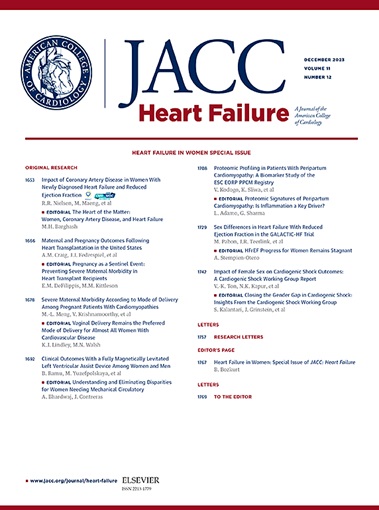Association of the 2018 U.S. Heart Allocation Policy Change and the Survival Benefit of Heart Transplantation
IF 10.3
1区 医学
Q1 CARDIAC & CARDIOVASCULAR SYSTEMS
引用次数: 0
Abstract
Background
In 2018, the U.S. heart allocation policy underwent a major change designed to increase the transplantation of the most medically urgent candidates.
Objectives
This study aims to determine the association between the 2018 policy change and the survival benefit of heart transplantation.
Methods
Observational study of the 23,043 U.S. adult heart transplant candidates listed before the policy change (October 2013 to October 2016) and a seasonally matched cohort listed after the policy change (October 2018 to October 2021). The main study outcome was the survival benefit of transplantation as defined by the increase in average days alive within 3 years following transplantation. The authors estimated survival with and without heart transplantation using a mixed-effects Cox proportional hazards model with transplant and status as time-dependent covariates and a random center-level intercept and transplant effect.
Results
Of the 11,022 candidates in the pre-policy cohort and 12,021 candidates in the post-policy cohort across 111 centers, 7,165 (65.0%) in the pre-policy cohort and 8,941 (74.4%) in the post-policy cohort underwent heart transplantation. Absolute 3-year survival benefit among the highest priority status candidates more than doubled after the policy change (327.8 days pre-policy vs 699.8 days post-policy; P < 0.001). All statuses experienced a positive long-run survival benefit of transplantation. The average 3-year survival benefit across all statuses increased from 217.1 days to 241.2 days per donor heart (P < 0.001). Overall, during the first 3 years after implementation, the 2018 heart allocation policy change was associated with an additional 1,645 life-years saved from transplantation (4,259 vs 5,904; P < 0.001).
Conclusions
The 2018 heart allocation policy change has led to better stratification and prioritization of candidates by clinical acuity, resulting in higher survival benefit of transplantation performed. Combined with higher transplantation rates, the 2018 heart allocation policy has saved thousands of life-years and achieved one of its major goals.
2018年美国心脏分配政策变化和心脏移植的生存益处协会
2018年,美国心脏分配政策发生了重大变化,旨在增加医学上最迫切的候选人的移植。目的本研究旨在确定2018年政策变化与心脏移植生存获益之间的关系。方法对政策改变前(2013年10月至2016年10月)列出的23,043名美国成人心脏移植候选人和政策改变后(2018年10月至2021年10月)列出的季节性匹配队列进行观察性研究。主要研究结果是移植的生存获益,定义为移植后3年内平均存活天数的增加。作者使用混合效应Cox比例风险模型,以移植和状态作为随时间变化的协变量,随机中心水平截距和移植效应来估计接受和不接受心脏移植的生存率。结果在111个中心的11022名政策前队列患者和12021名政策后队列患者中,7165名(65.0%)政策前队列患者和8941名(74.4%)政策后队列患者接受了心脏移植。政策改变后,最高优先状态候选人的绝对3年生存期增加了一倍多(政策前327.8天vs政策后699.8天;P & lt;0.001)。所有状态都经历了移植的积极的长期生存益处。每个供体心脏的平均3年生存期从217.1天增加到241.2天(P <;0.001)。总体而言,在实施后的前3年,2018年心脏分配政策的变化与移植额外节省的1645个生命年相关(4259对5904;P & lt;0.001)。结论2018年心脏分配政策的变化使候选患者的临床敏锐度得到更好的分层和优先排序,从而提高了移植的生存效益。结合更高的移植率,2018年的心脏分配政策节省了数千个生命年,实现了其主要目标之一。
本文章由计算机程序翻译,如有差异,请以英文原文为准。
求助全文
约1分钟内获得全文
求助全文
来源期刊

JACC. Heart failure
CARDIAC & CARDIOVASCULAR SYSTEMS-
CiteScore
21.20
自引率
2.30%
发文量
164
期刊介绍:
JACC: Heart Failure publishes crucial findings on the pathophysiology, diagnosis, treatment, and care of heart failure patients. The goal is to enhance understanding through timely scientific communication on disease, clinical trials, outcomes, and therapeutic advances. The Journal fosters interdisciplinary connections with neuroscience, pulmonary medicine, nephrology, electrophysiology, and surgery related to heart failure. It also covers articles on pharmacogenetics, biomarkers, and metabolomics.
 求助内容:
求助内容: 应助结果提醒方式:
应助结果提醒方式:


